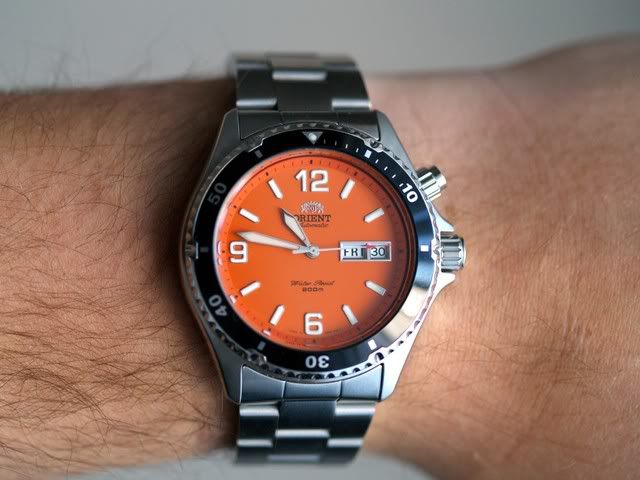"Dear C,
I am really getting discouraged by some of your posts, I mean, my kids are cute but they aren't super-cute like yours. Also, I sometimes feel like I fall short in trying to be as good of a parent, or husband, or Internet author as you are. Kindly tone down the awesomeness of your blog, I think it will be more accessible to a wider audience of people if you do.
Loyally yours,
[ name removed ]
ps - I have always admired the patience you have shown in dealing with a certain one of your sisters, that must be really tough for you sometimes."
I want the readers to know that I open each letter and gift package we receive, and in response to this sentiment, I will not be talking about us at all in this post. The following treatise on watches is not meant to be exhaustive or even historically accurate, but I hope that someone learns something from this interesting topic:
Mechanicals:

This is old-school time-telling right here. Mechanical watches didn't have any batteries or circuits, they are powered by a coiled spring. On some watches, the spring is wound by the owner turning the crown (handwind) and on some the spring is connected to a pendulum weight inside the case that spins around when the wearer moves his or her hand (automatic).
Here you can see the weighted rotor that winds the spring:

The most complicated and expensive part of any watch is the escapement which controls the rate at which the mainspring unwinds and divides the movement into units of time. On some watch dials you might notice writing that tells how many jewels the watch has. I was always stumped by this and thought that the jewels were a decorative thing (even though I couldn't see any). What I have learned was that small jewels (usually rubies or man-made sapphires) are used inside the movement to reduce the friction of the moving parts and increase longevity by reducing the wear that would occur if metal rubbed against metal 24 hours/day.

Mechanical watches are not as common today and have been almost completely replaced by the modern quartz watch which is much cheaper to produce, and much more accurate. Even a very expensive mechanical watch will only be accurate to 15-30 seconds/day while a cheap Walmart quartz watch will be in the range of 15-30 seconds/month! You can easily spot a mechanical watch by the movement of its seconds hand. A quartz will only tick once per second while a mechanical will tick 6 times per second (or 8 times in hi-beat movements). The result is a nice smooth sweeping second hand motion.
Because of their history and complexity, mechanical watches are still preferred by connoisseurs who view them as having more "soul" than modern battery powered timepieces. The expensive luxury brands are almost exclusively mechanical for this reason. The higher cost mechanicals sometimes come with a COSC certification which means that a Swiss institute (Contrôle Officiel Suisse des Chronomètres) has measured and adjusted each individual watch and has approved it as chronometer, guaranteeing it will lose no more that 4 second per day and gain no more than 6 seconds per day. Rolex and Breitling are some of the more common examples of COSC chronometers. It is crazy to think that a $5,000 Rolex will still not be as accurate as Mason's plastic Timex with the lizard-shaped seconds hand. But the engineering that goes into a mechanical watch is simply amazing and I can not fathom that in the 1600's people were already building them.
Here is the only mechanical I own:
An Orient 200m dive watch:

Orient is one of the big three Japanese companies (with Seiko and Citizen) but is not as commonly known because they stuck to producing mechanicals while the other two companies embraced quartz and sell worldwide. This watch is not expensive (only $100 or so) but I think it is one of the best values out there. It has a 21-jewel automatic movement that is made in-house, not mass produced by one company and plunked into different brands like some watches. Both of it's crowns are threaded and screw down to make the entire case water-tight to 200ms, hence placing it in the dive watch category. I don't scuba dive but I sometimes put this watch on just to shower or do the dishes : ) It is 8 seconds slow per day which isn't too hot compared to quartz, but when you consider that it uses a metal spring and a nest of gears and cogs and only misplaces 8 of the 86400 second in a day, well, that is an incredible feat and an amazing human achievement.
- C
2 comments:
Wow, you get letters from "creapy blog guy" too. What a punk hey... to be so rude about Tanis. Geesh. Funny how you can almost predict the type of person people are through what they write huh? I predict the author of the letter you recieved was probably male, kinda awkward looking, very self centered...and probably grew up being quite spoiled in his life! What do you think? As for the watch, what an enlightening post. I didn't even KNOW YOU HAD SUCH A COOL WATCH. Why haven't you ever mentioned it 100 times or showed it to me before?
tHaT wAs rEaLLy rUde
wHy dO yOu jUge mE?
So hEy wHaT hAVe yOu bEnn uP tO lAtley? yOur bLog hAsnT bEeN wOrKing lAtley...
Post a Comment